Abstract
The assessment of behavioral changes produced by prenatal or early postnatal exposure to potentially noxious agents requires both the designing of ad hoc tests and the adaptation of tests for adult animals to the characteristics of successive developmental stages. The experience in designing tests is still more limited than in the adaptation of tests, but several tests have already proven their usefulness; some examples are the suckling test, the homing test, and evaluations of dam-pup and pup-pup interactions. Functional observational batteries can exploit the development at specified postnatal ages of several reflexes and responses that are absent at birth in altricial rodent species with a short pregnancy such as the rat and the mouse. In neonates, the assessment of early treatment effects can rely not only on deviations from normal responding but also on changes in the time of appearance of otherwise normal response patterns. The same applies to other end points such as responses to pain and various types of spontaneous motor/exploratory activities, including reactivity to a variety of drug challenges that can provide information on the regulatory systems whose development may be affected by early treatments. In particular, the analysis of ontogenetic dissociations (i.e., differential early treatment effects depending jointly on developmental stage at the time of exposure, age of testing, and response end point) can be of considerable value in the study of treatments' mechanisms of action. Overall, it appears that behavioral teratological assessments can be effectively used both proactively, i.e., in risk assessment prior to any human exposure, and reactively. In the latter case, these assessments could have special value in the face of agents suspected to produce borderline changes in developing humans, whose innocuousness or noxiousness can be difficult to establish in the absence of hard evidence of teratogenicity.
Full text
PDF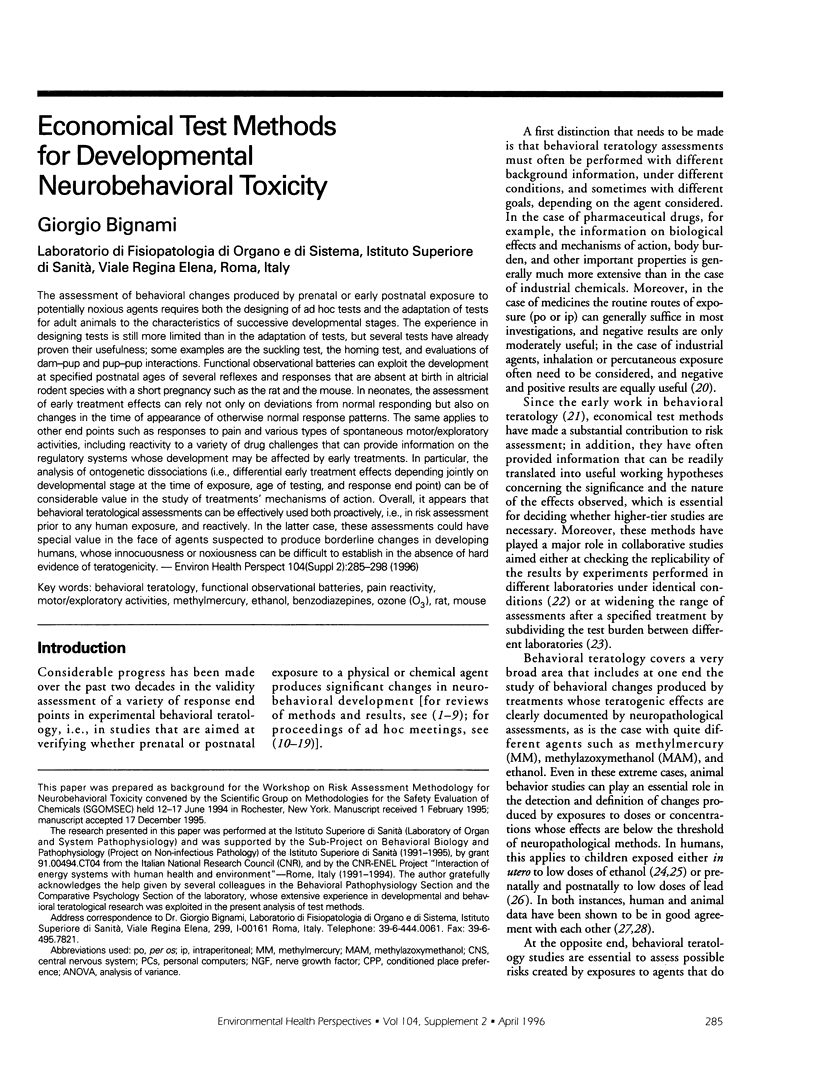
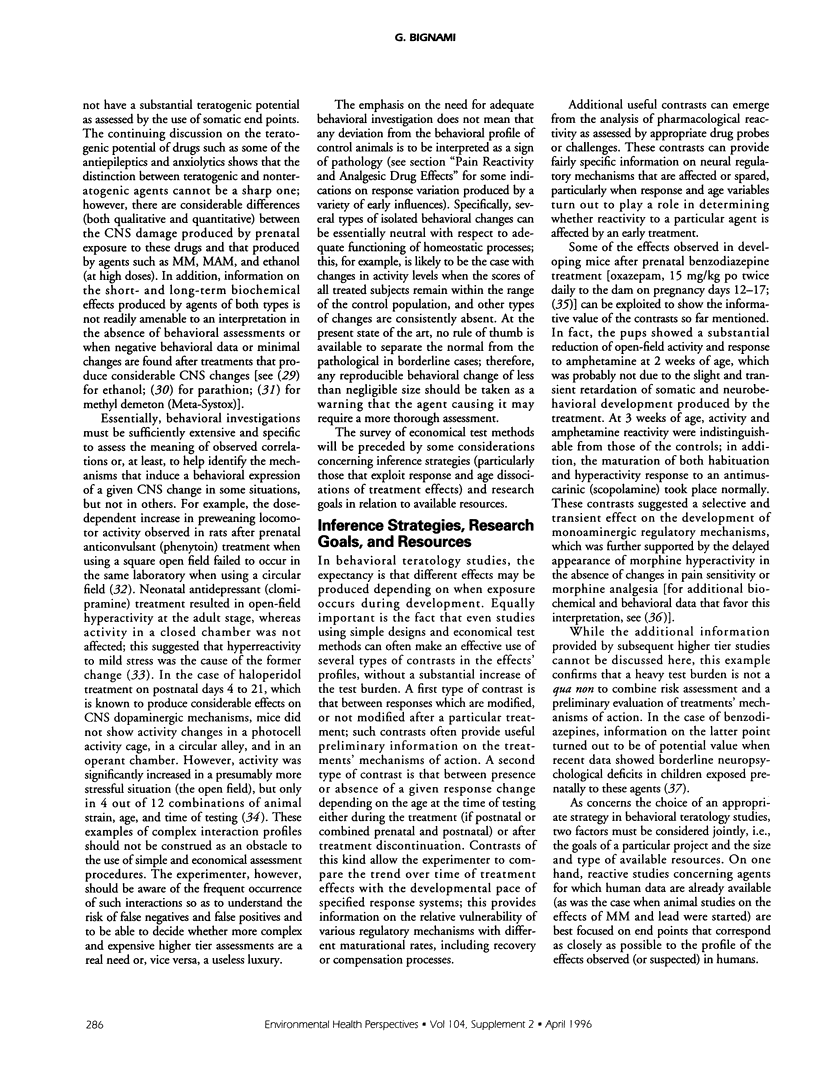
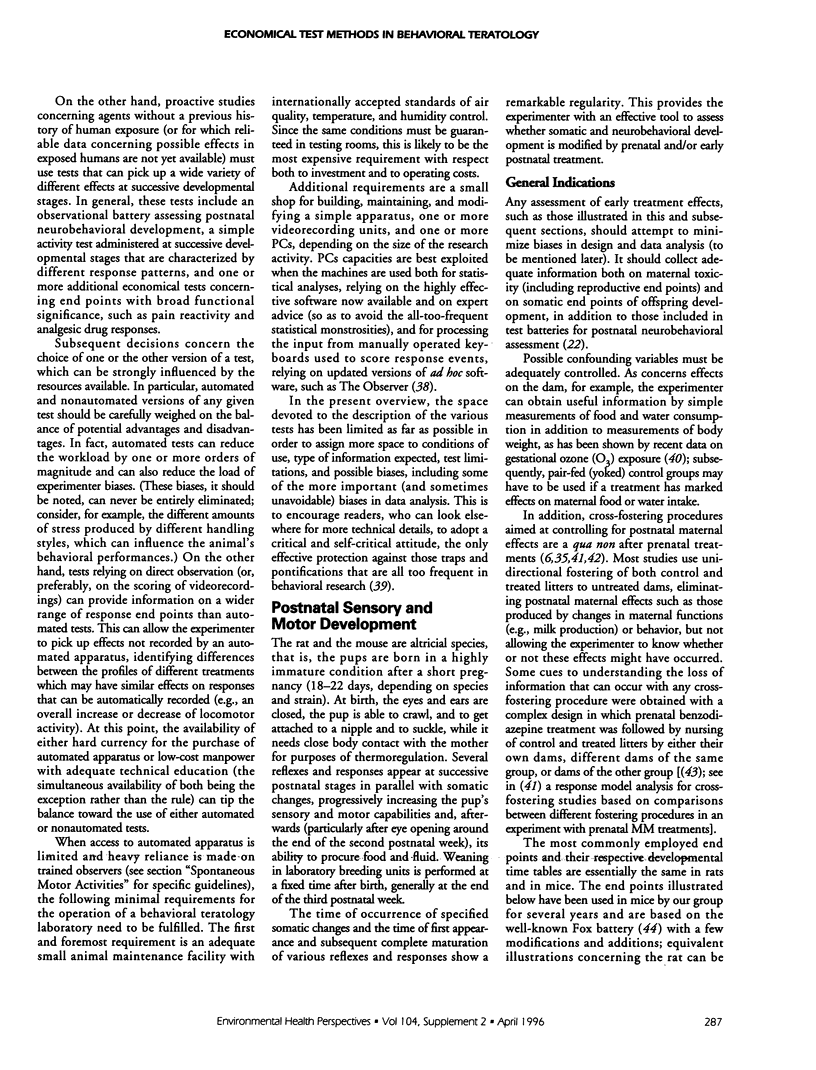
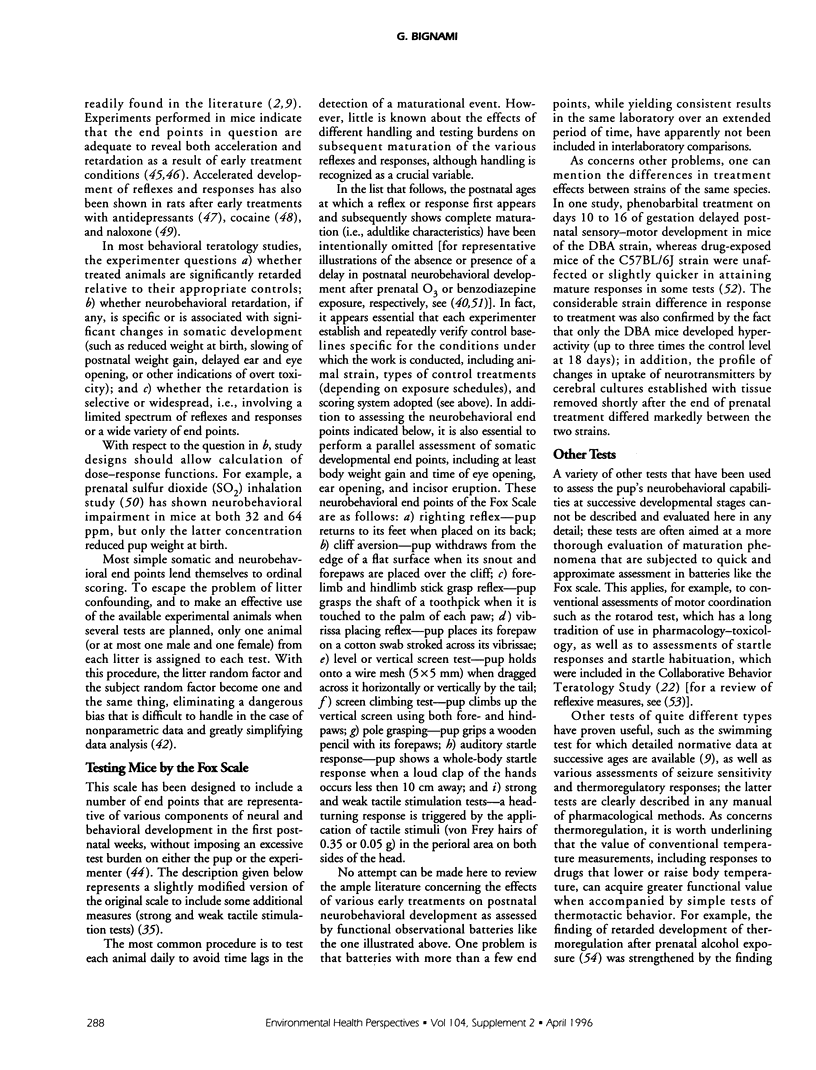
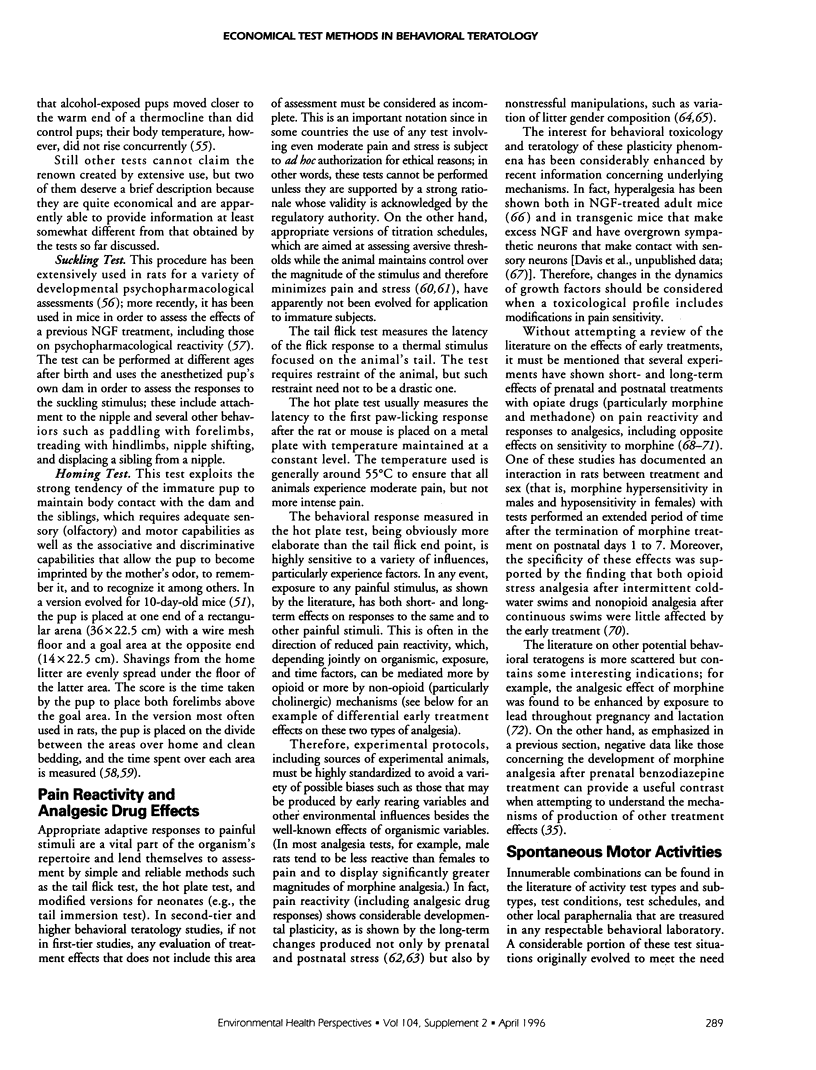
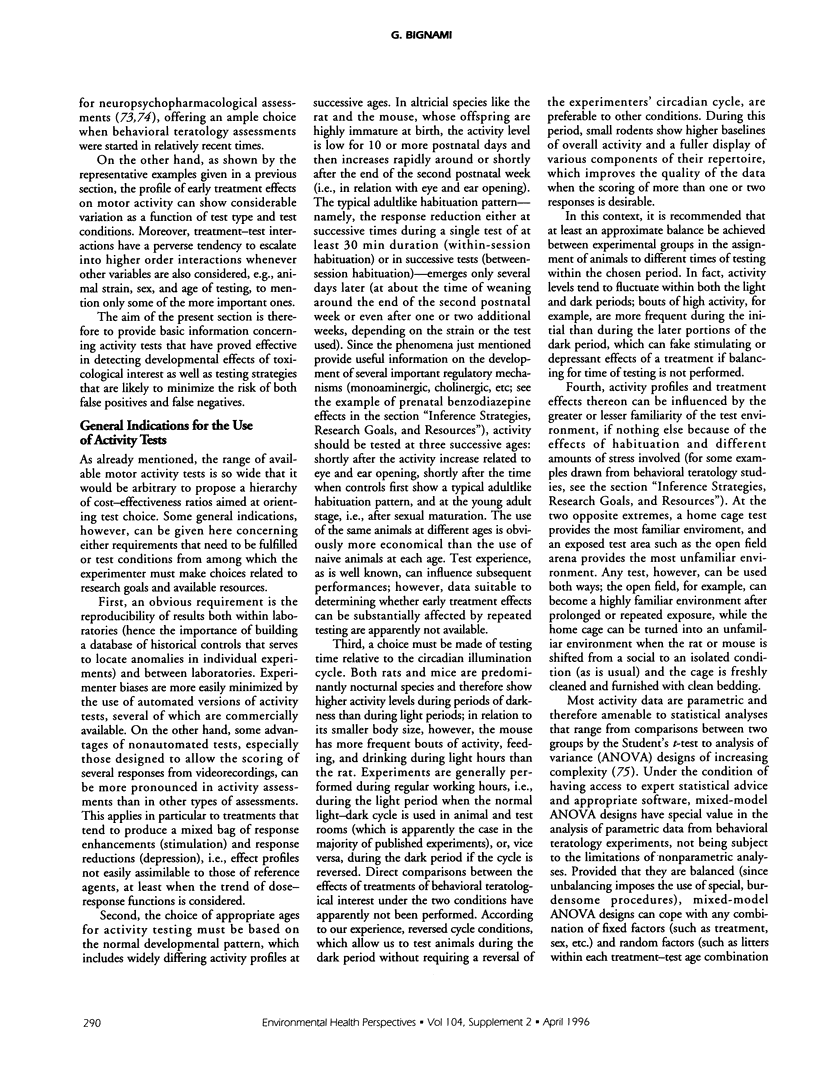
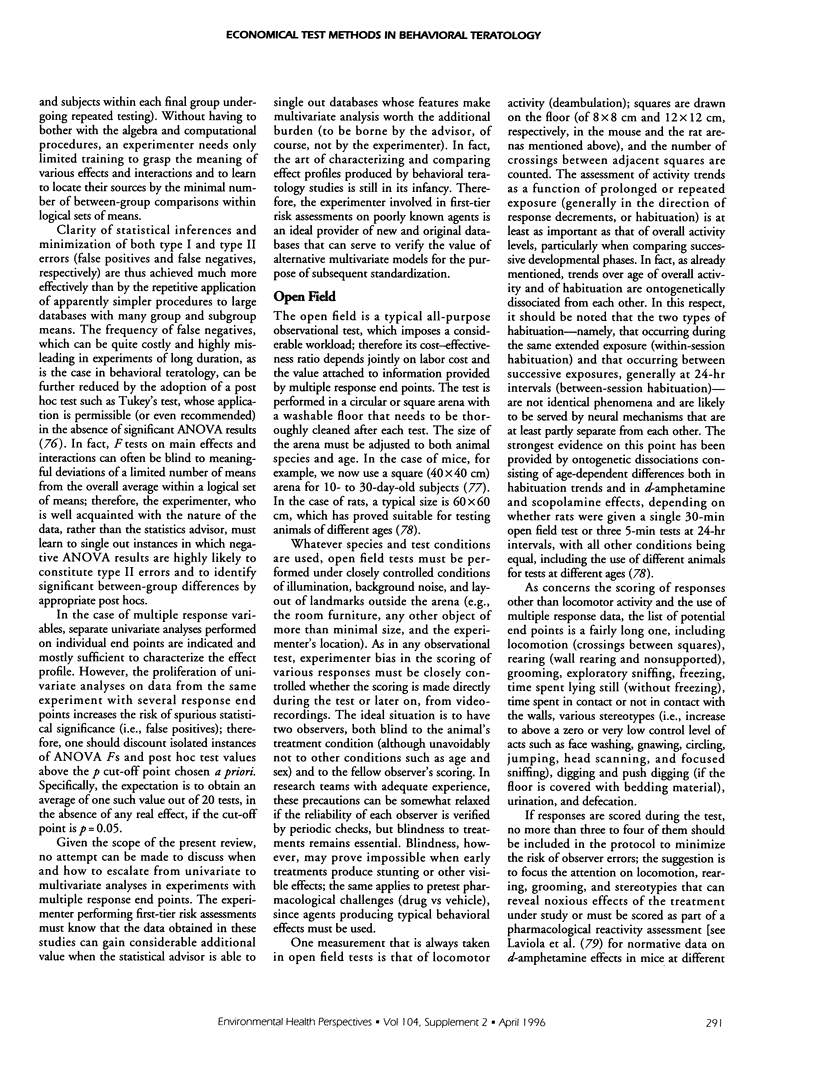

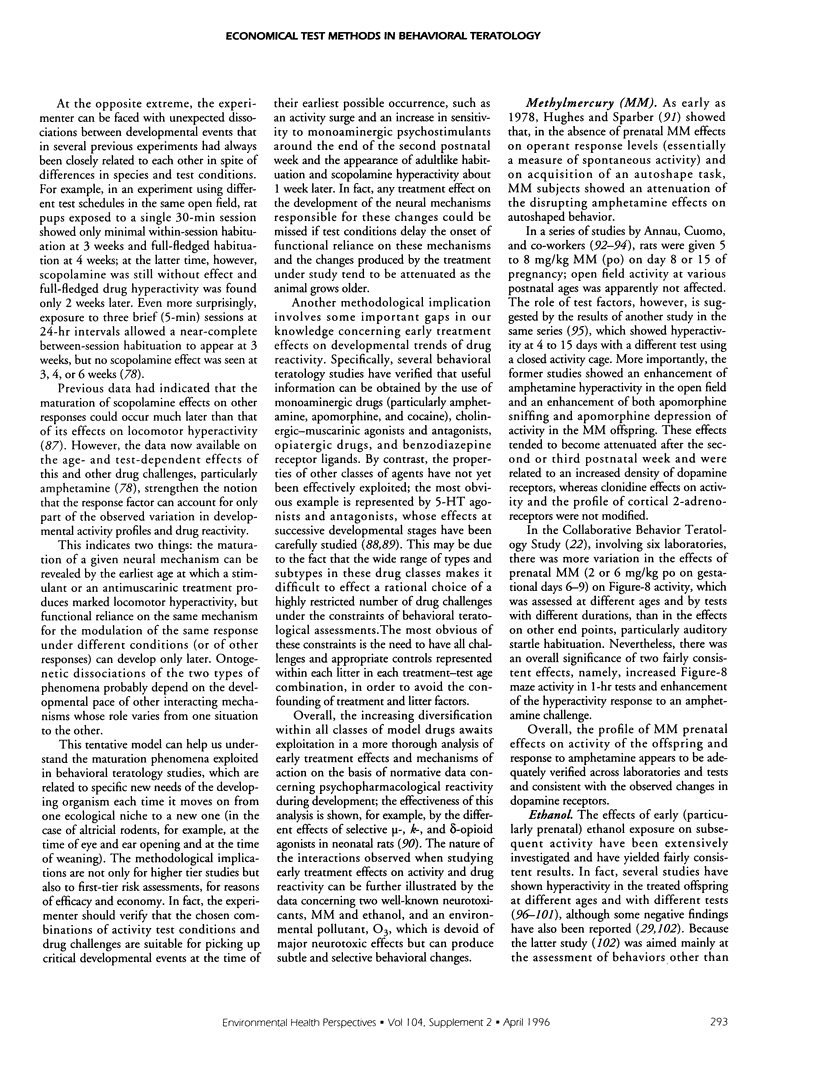
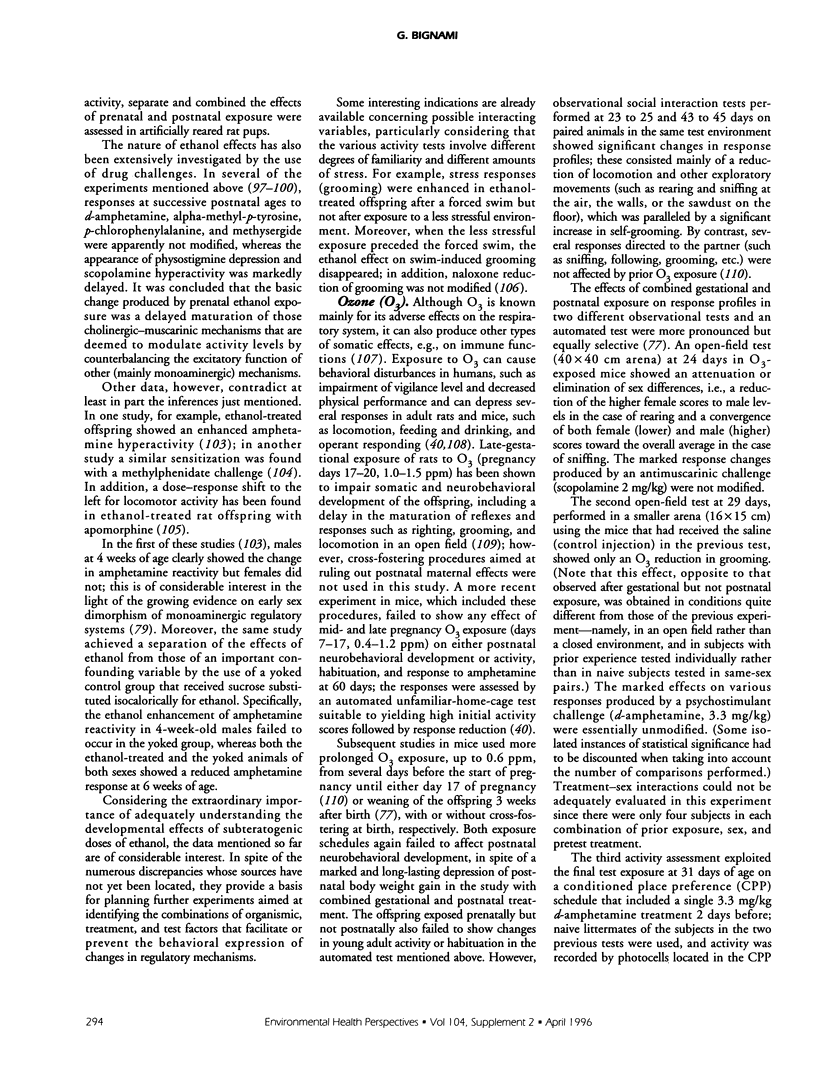
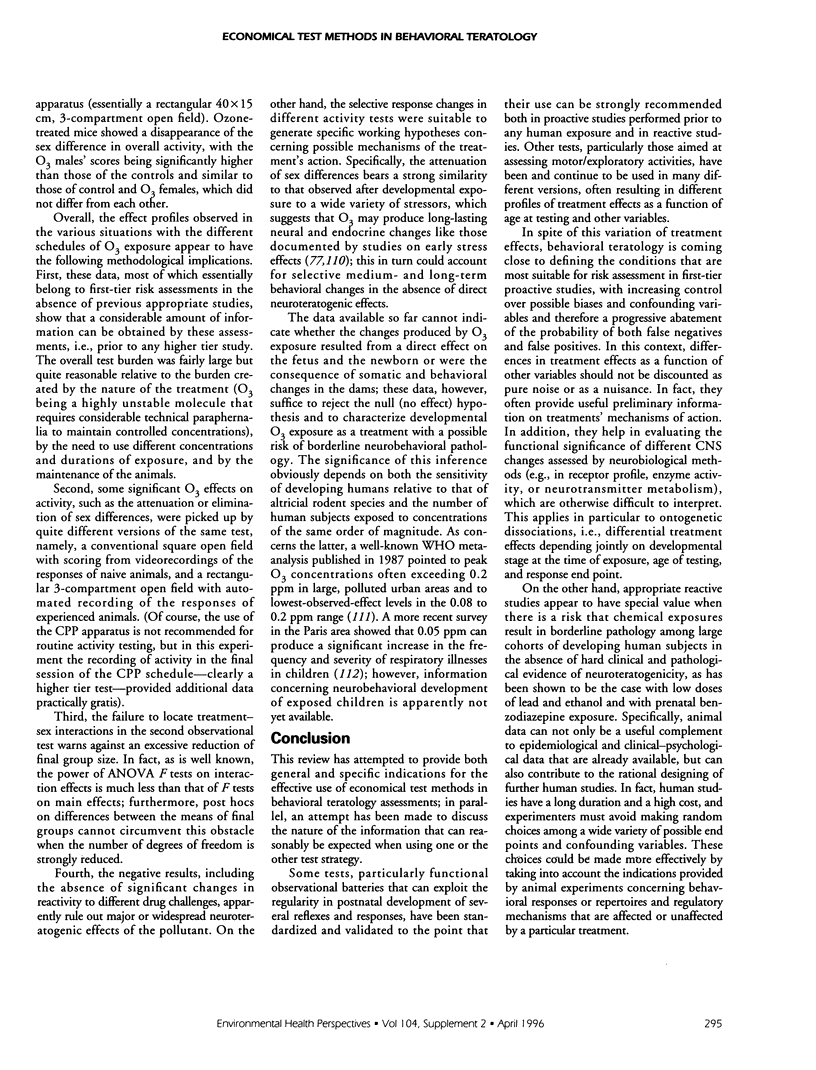

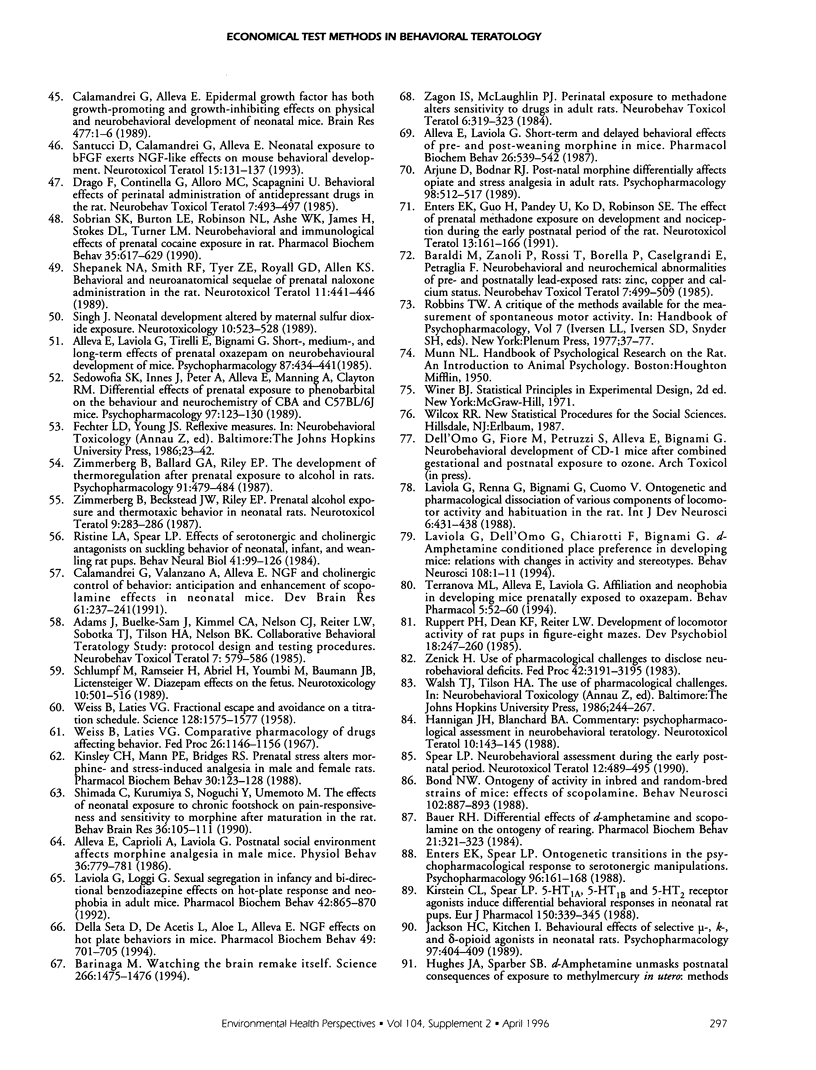
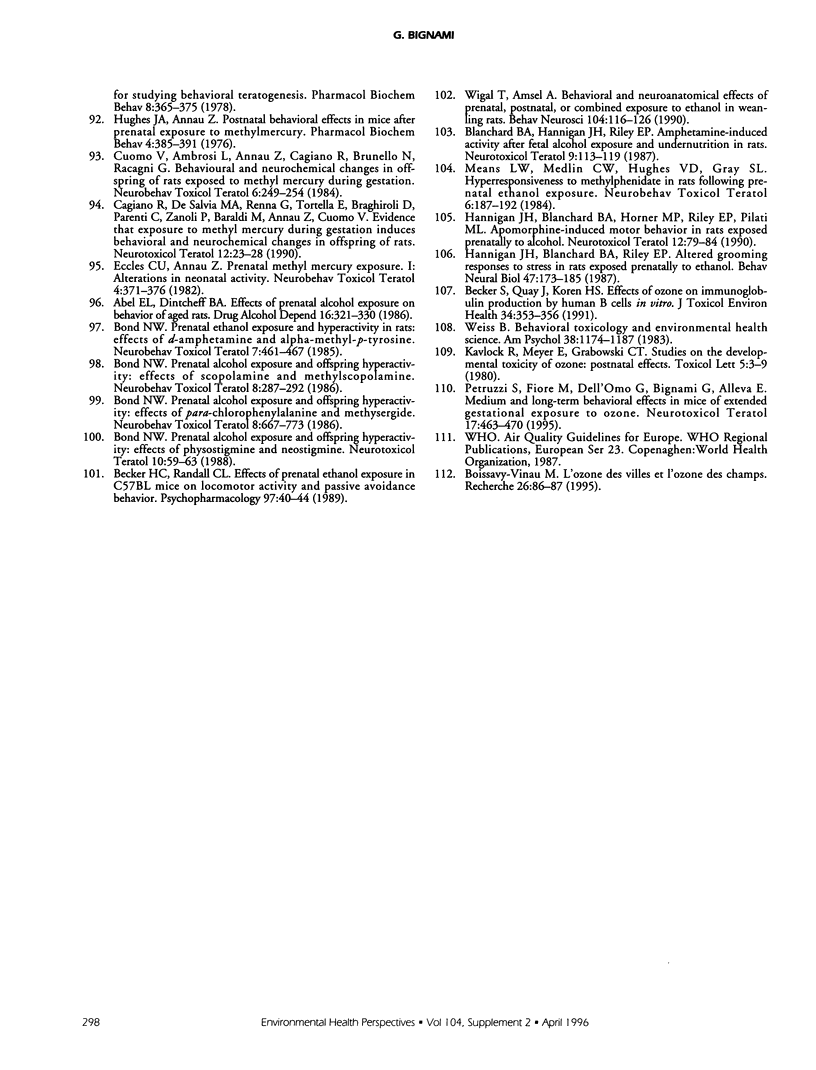
Selected References
These references are in PubMed. This may not be the complete list of references from this article.
- Abel E. L., Dintcheff B. A. Effects of prenatal alcohol exposure on behavior of aged rats. Drug Alcohol Depend. 1986 Feb;16(4):321–330. doi: 10.1016/0376-8716(86)90066-9. [DOI] [PubMed] [Google Scholar]
- Adams J., Buelke-Sam J., Kimmel C. A., Nelson C. J., Reiter L. W., Sobotka T. J., Tilson H. A., Nelson B. K. Collaborative Behavioral Teratology Study: protocol design and testing procedures. Neurobehav Toxicol Teratol. 1985 Nov-Dec;7(6):579–586. [PubMed] [Google Scholar]
- Alleva E., Caprioli A., Laviola G. Postnatal social environment affects morphine analgesia in male mice. Physiol Behav. 1986;36(4):779–781. doi: 10.1016/0031-9384(86)90368-9. [DOI] [PubMed] [Google Scholar]
- Alleva E., Laviola G. Short-term and delayed behavioral effects of pre- and post-weaning morphine in mice. Pharmacol Biochem Behav. 1987 Mar;26(3):539–542. doi: 10.1016/0091-3057(87)90162-6. [DOI] [PubMed] [Google Scholar]
- Alleva E., Laviola G., Tirelli E., Bignami G. Short-, medium-, and long-term effects of prenatal oxazepam on neurobehavioural development of mice. Psychopharmacology (Berl) 1985;87(4):434–441. doi: 10.1007/BF00432509. [DOI] [PubMed] [Google Scholar]
- Arjune D., Bodnar R. J. Post-natal morphine differentially affects opiate and stress analgesia in adult rats. Psychopharmacology (Berl) 1989;98(4):512–517. doi: 10.1007/BF00441951. [DOI] [PubMed] [Google Scholar]
- Baraldi M., Zanoli P., Rossi T., Borella P., Caselgrandi E., Petraglia F. Neurobehavioral and neurochemical abnormalities of pre- and postnatally lead-exposed rats: zinc, copper and calcium status. Neurobehav Toxicol Teratol. 1985 Sep-Oct;7(5):499–509. [PubMed] [Google Scholar]
- Barinaga M. Watching the brain remake itself. Science. 1994 Dec 2;266(5190):1475–1476. doi: 10.1126/science.7985011. [DOI] [PubMed] [Google Scholar]
- Bauer R. H. Differential effects of d-amphetamine and scopolamine on the ontogeny of rearing. Pharmacol Biochem Behav. 1984 Aug;21(2):321–323. doi: 10.1016/0091-3057(84)90233-8. [DOI] [PubMed] [Google Scholar]
- Becker H. C., Randall C. L. Effects of prenatal ethanol exposure in C57BL mice on locomotor activity and passive avoidance behavior. Psychopharmacology (Berl) 1989;97(1):40–44. doi: 10.1007/BF00443410. [DOI] [PubMed] [Google Scholar]
- Becker S., Quay J., Koren H. S. Effect of ozone on immunoglobulin production by human B cells in vitro. J Toxicol Environ Health. 1991 Nov;34(3):353–366. doi: 10.1080/15287399109531573. [DOI] [PubMed] [Google Scholar]
- Bignami G., Alleva E., Chiarotti F., Laviola G. Selective changes in mouse behavioral development after prenatal benzodiazepine exposure: a progress report. Prog Neuropsychopharmacol Biol Psychiatry. 1992 Sep;16(5):587–604. doi: 10.1016/0278-5846(92)90017-9. [DOI] [PubMed] [Google Scholar]
- Bignami G., Musi B., Dell'Omo G., Laviola G., Alleva E. Limited effects of ozone exposure during pregnancy on physical and neurobehavioral development of CD-1 mice. Toxicol Appl Pharmacol. 1994 Dec;129(2):264–271. doi: 10.1006/taap.1994.1251. [DOI] [PubMed] [Google Scholar]
- Blanchard B. A., Hannigan J. H., Riley E. P. Amphetamine-induced activity after fetal alcohol exposure and undernutrition in rats. Neurotoxicol Teratol. 1987 Mar-Apr;9(2):113–119. doi: 10.1016/0892-0362(87)90087-0. [DOI] [PubMed] [Google Scholar]
- Bond N. W. Ontogeny of activity in inbred and random-bred strains of mice: effects of scopolamine. Behav Neurosci. 1988 Dec;102(6):887–893. doi: 10.1037//0735-7044.102.6.887. [DOI] [PubMed] [Google Scholar]
- Bond N. W. Prenatal alcohol exposure and offspring hyperactivity: effects of para-chlorophenylalanine and methysergide. Neurobehav Toxicol Teratol. 1986 Nov-Dec;8(6):667–673. [PubMed] [Google Scholar]
- Bond N. W. Prenatal alcohol exposure and offspring hyperactivity: effects of physostigmine and neostigmine. Neurotoxicol Teratol. 1988 Jan-Feb;10(1):59–63. doi: 10.1016/0892-0362(88)90067-0. [DOI] [PubMed] [Google Scholar]
- Bond N. W. Prenatal alcohol exposure and offspring hyperactivity: effects of scopolamine and methylscopolamine. Neurobehav Toxicol Teratol. 1986 May-Jun;8(3):287–292. [PubMed] [Google Scholar]
- Bond N. W. Prenatal ethanol exposure and hyperactivity in rats: effects of d-amphetamine and alpha-methyl-p-tyrosine. Neurobehav Toxicol Teratol. 1985 Sep-Oct;7(5):461–467. [PubMed] [Google Scholar]
- Cagiano R., De Salvia M. A., Renna G., Tortella E., Braghiroli D., Parenti C., Zanoli P., Baraldi M., Annau Z., Cuomo V. Evidence that exposure to methyl mercury during gestation induces behavioral and neurochemical changes in offspring of rats. Neurotoxicol Teratol. 1990 Jan-Feb;12(1):23–28. doi: 10.1016/0892-0362(90)90108-o. [DOI] [PubMed] [Google Scholar]
- Calamandrei G., Alleva E. Epidermal growth factor has both growth-promoting and growth-inhibiting effects on physical and neurobehavioral development of neonatal mice. Brain Res. 1989 Jan 16;477(1-2):1–6. doi: 10.1016/0006-8993(89)91387-5. [DOI] [PubMed] [Google Scholar]
- Calamandrei G., Valanzano A., Alleva E. NGF and cholinergic control of behavior: anticipation and enhancement of scopolamine effects in neonatal mice. Brain Res Dev Brain Res. 1991 Aug 19;61(2):237–241. doi: 10.1016/0165-3806(91)90136-7. [DOI] [PubMed] [Google Scholar]
- Chiarotti F., Alleva E., Bignami G. Problems of test choice and data analysis in behavioral teratology: the case of prenatal benzodiazepines. Neurotoxicol Teratol. 1987 Mar-Apr;9(2):179–186. doi: 10.1016/0892-0362(87)90096-1. [DOI] [PubMed] [Google Scholar]
- Clemens G. R., Hartnagel R. E., Bare J. J., Thyssen J. H. Teratological, neurochemical, and postnatal neurobehavioral assessment of METASYSTOX-R, an organophosphate pesticide in the rat. Fundam Appl Toxicol. 1990 Jan;14(1):131–143. doi: 10.1016/0272-0590(90)90239-g. [DOI] [PubMed] [Google Scholar]
- Coyle I., Wayner M. J., Singer G. Behavioral teratogenesis: a critical evaluation. Pharmacol Biochem Behav. 1976 Feb;4(2):191–200. doi: 10.1016/0091-3057(76)90014-9. [DOI] [PubMed] [Google Scholar]
- Cuomo V., Ambrosi L., Annau Z., Cagiano R., Brunello N., Racagni G. Behavioural and neurochemical changes in offspring of rats exposed to methyl mercury during gestation. Neurobehav Toxicol Teratol. 1984 May-Jun;6(3):249–254. [PubMed] [Google Scholar]
- Dallemagne G., Weiss B. Altered adult behavior of mice following postnatal treatment with haloperidol. Pharmacol Biochem Behav. 1982 May;16(5):761–767. doi: 10.1016/0091-3057(82)90232-5. [DOI] [PubMed] [Google Scholar]
- Davis J. M., Otto D. A., Weil D. E., Grant L. D. The comparative developmental neurotoxicity of lead in humans and animals. Neurotoxicol Teratol. 1990 May-Jun;12(3):215–229. doi: 10.1016/0892-0362(90)90093-r. [DOI] [PubMed] [Google Scholar]
- Della Seta D., de Acetis L., Aloe L., Alleva E. NGF effects on hot plate behaviors in mice. Pharmacol Biochem Behav. 1994 Nov;49(3):701–705. doi: 10.1016/0091-3057(94)90090-6. [DOI] [PubMed] [Google Scholar]
- Drago F., Continella G., Alloro M. C., Scapagnini U. Behavioral effects of perinatal administration of antidepressant drugs in the rat. Neurobehav Toxicol Teratol. 1985 Sep-Oct;7(5):493–497. [PubMed] [Google Scholar]
- Driscoll C. D., Streissguth A. P., Riley E. P. Prenatal alcohol exposure: comparability of effects in humans and animal models. Neurotoxicol Teratol. 1990 May-Jun;12(3):231–237. doi: 10.1016/0892-0362(90)90094-s. [DOI] [PubMed] [Google Scholar]
- Eccles C. U., Annau Z. Prenatal methyl mercury exposure: I. Alterations in neonatal activity. Neurobehav Toxicol Teratol. 1982 May-Jun;4(3):371–376. [PubMed] [Google Scholar]
- Elia J., Katz I. R., Simpson G. M. Teratogenicity of psychotherapeutic medications. Psychopharmacol Bull. 1987;23(4):531–586. [PubMed] [Google Scholar]
- Elsner J., Hodel B., Suter K. E., Oelke D., Ulbrich B., Schreiner G., Cuomo V., Cagiano R., Rosengren L. E., Karlsson J. E. Detection limits of different approaches in behavioral teratology, and correlation of effects with neurochemical parameters. Neurotoxicol Teratol. 1988 Mar-Apr;10(2):155–167. doi: 10.1016/0892-0362(88)90080-3. [DOI] [PubMed] [Google Scholar]
- Enters E. K., Guo H. Z., Pandey U., Ko D. J., Robinson S. E. The effect of prenatal methadone exposure on development and nociception during the early postnatal period of the rat. Neurotoxicol Teratol. 1991 Mar-Apr;13(2):161–166. doi: 10.1016/0892-0362(91)90006-i. [DOI] [PubMed] [Google Scholar]
- Enters E. K., Spear L. P. Ontogenetic transitions in the psychopharmacological response to serotonergic manipulations. Psychopharmacology (Berl) 1988;96(2):161–168. doi: 10.1007/BF00177555. [DOI] [PubMed] [Google Scholar]
- Fox W. M. Reflex-ontogeny and behavioural development of the mouse. Anim Behav. 1965 Apr-Jul;13(2):234–241. doi: 10.1016/0003-3472(65)90041-2. [DOI] [PubMed] [Google Scholar]
- Francis E. Z., Kimmel C. A., Rees D. C. Workshop on the qualitative and quantitative comparability of human and animal developmental neurotoxicity: summary and implications. Neurotoxicol Teratol. 1990 May-Jun;12(3):285–292. doi: 10.1016/0892-0362(90)90101-h. [DOI] [PubMed] [Google Scholar]
- Fried P. A., Watkinson B. 36- and 48-month neurobehavioral follow-up of children prenatally exposed to marijuana, cigarettes, and alcohol. J Dev Behav Pediatr. 1990 Apr;11(2):49–58. [PubMed] [Google Scholar]
- Gruen R. J., Deutch A. Y., Roth R. H. Perinatal diazepam exposure: alterations in exploratory behavior and mesolimbic dopamine turnover. Pharmacol Biochem Behav. 1990 May;36(1):169–175. doi: 10.1016/0091-3057(90)90144-7. [DOI] [PubMed] [Google Scholar]
- Hannigan J. H., Blanchard B. A. Commentary: psychopharmacological assessment in neurobehavioral teratology. Neurotoxicol Teratol. 1988 Mar-Apr;10(2):143–145. doi: 10.1016/0892-0362(88)90078-5. [DOI] [PubMed] [Google Scholar]
- Hannigan J. H., Blanchard B. A., Horner M. P., Riley E. P., Pilati M. L. Apomorphine-induced motor behavior in rats exposed prenatally to alcohol. Neurotoxicol Teratol. 1990 Mar-Apr;12(2):79–84. doi: 10.1016/0892-0362(90)90116-t. [DOI] [PubMed] [Google Scholar]
- Hannigan J. H., Blanchard B. A., Riley E. P. Altered grooming responses to stress in rats exposed prenatally to ethanol. Behav Neural Biol. 1987 Mar;47(2):173–185. doi: 10.1016/s0163-1047(87)90299-8. [DOI] [PubMed] [Google Scholar]
- Hartley P., Neill D., Hagler M., Kors D., Vogel G. Procedure- and age-dependent hyperactivity in a new animal model of endogenous depression. Neurosci Biobehav Rev. 1990 Spring;14(1):69–72. doi: 10.1016/s0149-7634(05)80161-7. [DOI] [PubMed] [Google Scholar]
- Hughes J. A., Annau Z. Postnatal behavioral effects in mice after prenatal exposure to methylmercury. Pharmacol Biochem Behav. 1976 Apr;4(4):385–391. doi: 10.1016/0091-3057(76)90052-6. [DOI] [PubMed] [Google Scholar]
- Jackson H. C., Kitchen I. Behavioural effects of selective mu-, kappa-, and delta-opioid agonists in neonatal rats. Psychopharmacology (Berl) 1989;97(3):404–409. doi: 10.1007/BF00439459. [DOI] [PubMed] [Google Scholar]
- Kavlock R. J., Meyer E., Grabowski C. T. Studies on the developmental toxicity of ozone: postnatal effects. Toxicol Lett. 1980 Jan;5(1):3–9. doi: 10.1016/0378-4274(80)90141-1. [DOI] [PubMed] [Google Scholar]
- Kinsley C. H., Mann P. E., Bridges R. S. Prenatal stress alters morphine- and stress-induced analgesia in male and female rats. Pharmacol Biochem Behav. 1988 May;30(1):123–128. doi: 10.1016/0091-3057(88)90434-0. [DOI] [PubMed] [Google Scholar]
- Kirstein C. L., Spear L. P. 5-HT1A, 5-HT1B and 5-HT2 receptor agonists induce differential behavioral responses in neonatal rat pups. Eur J Pharmacol. 1988 Jun 10;150(3):339–345. doi: 10.1016/0014-2999(88)90016-7. [DOI] [PubMed] [Google Scholar]
- Laviola G., Bignami G., Alleva E. Interacting effects of oxazepam in late pregnancy and fostering procedure on mouse maternal behavior. Neurosci Biobehav Rev. 1991 Winter;15(4):501–504. doi: 10.1016/s0149-7634(05)80139-3. [DOI] [PubMed] [Google Scholar]
- Laviola G., Loggi G. Sexual segregation in infancy and bi-directional benzodiazepine effects on hot-plate response and neophobia in adult mice. Pharmacol Biochem Behav. 1992 Aug;42(4):865–870. doi: 10.1016/0091-3057(92)90042-e. [DOI] [PubMed] [Google Scholar]
- Laviola G., Renna G., Bignami G., Cuomo V. Ontogenetic and pharmacological dissociation of various components of locomotor activity and habituation in the rat. Int J Dev Neurosci. 1988;6(5):431–438. doi: 10.1016/0736-5748(88)90049-4. [DOI] [PubMed] [Google Scholar]
- Means L. W., Medlin C. W., Hughes V. D., Gray S. L. Hyperresponsiveness to methylphenidate in rats following prenatal ethanol exposure. Neurobehav Toxicol Teratol. 1984 May-Jun;6(3):187–192. [PubMed] [Google Scholar]
- Needleman H. L., Bellinger D. The health effects of low level exposure to lead. Annu Rev Public Health. 1991;12:111–140. doi: 10.1146/annurev.pu.12.050191.000551. [DOI] [PubMed] [Google Scholar]
- Nelson B. K., Brightwell W. S., MacKenzie-Taylor D. R., Burg J. R., Massari V. J. Neurochemical, but not behavioral, deviations in the offspring of rats following prenatal or paternal inhalation exposure to ethanol. Neurotoxicol Teratol. 1988 Jan-Feb;10(1):15–22. doi: 10.1016/0892-0362(88)90062-1. [DOI] [PubMed] [Google Scholar]
- Nelson B. K. Origins of behavioral teratology and distinctions between research on pharmaceutical agents and environmental/industrial chemicals. Neurotoxicol Teratol. 1990 Jul-Aug;12(4):301–305. doi: 10.1016/0892-0362(90)90047-g. [DOI] [PubMed] [Google Scholar]
- Petruzzi S., Fiore M., Dell'Omo G., Bignami G., Alleva E. Medium and long-term behavioral effects in mice of extended gestational exposure to ozone. Neurotoxicol Teratol. 1995 Jul-Aug;17(4):463–470. doi: 10.1016/0892-0362(95)00003-a. [DOI] [PubMed] [Google Scholar]
- Ristine L. A., Spear L. P. Effects of serotonergic and cholinergic antagonists on suckling behavior of neonatal, infant, and weanling rat pups. Behav Neural Biol. 1984 Jul;41(2):99–126. doi: 10.1016/s0163-1047(84)90485-0. [DOI] [PubMed] [Google Scholar]
- Ruppert P. H., Dean K. F., Reiter L. W. Development of locomotor activity of rat pups in figure-eight mazes. Dev Psychobiol. 1985 May;18(3):247–260. doi: 10.1002/dev.420180305. [DOI] [PubMed] [Google Scholar]
- Santucci D., Calamandrei G., Alleva E. Neonatal exposure to bFGF exerts NGF-like effects on mouse behavioral development. Neurotoxicol Teratol. 1993 Mar-Apr;15(2):131–137. doi: 10.1016/0892-0362(93)90071-u. [DOI] [PubMed] [Google Scholar]
- Schlumpf M., Ramseier H., Abriel H., Youmbi M., Baumann J. B., Lictensteiger W. Diazepam effects on the fetus. Neurotoxicology. 1989 Fall;10(3):501–516. [PubMed] [Google Scholar]
- Sedowofia S. K., Innes J., Peter A., Alleva E., Manning A., Clayton R. M. Differential effects of prenatal exposure to phenobarbital on the behaviour and neurochemistry of CBA and C57BL/6J mice. Psychopharmacology (Berl) 1989;97(1):123–130. doi: 10.1007/BF00443426. [DOI] [PubMed] [Google Scholar]
- Shepanek N. A., Smith R. F., Tyer Z. E., Royall G. D., Allen K. S. Behavioral and neuroanatomical sequelae of prenatal naloxone administration in the rat. Neurotoxicol Teratol. 1989 Sep-Oct;11(5):441–446. doi: 10.1016/0892-0362(89)90021-4. [DOI] [PubMed] [Google Scholar]
- Shimada C., Kurumiya S., Noguchi Y., Umemoto M. The effect of neonatal exposure to chronic footshock on pain-responsiveness and sensitivity to morphine after maturation in the rat. Behav Brain Res. 1990 Jan 1;36(1-2):105–111. doi: 10.1016/0166-4328(90)90165-b. [DOI] [PubMed] [Google Scholar]
- Singh J. Neonatal development altered by maternal sulfur dioxide exposure. Neurotoxicology. 1989 Fall;10(3):523–527. [PubMed] [Google Scholar]
- Sobrian S. K., Burton L. E., Robinson N. L., Ashe W. K., James H., Stokes D. L., Turner L. M. Neurobehavioral and immunological effects of prenatal cocaine exposure in rat. Pharmacol Biochem Behav. 1990 Mar;35(3):617–629. doi: 10.1016/0091-3057(90)90299-w. [DOI] [PubMed] [Google Scholar]
- Sonderegger T. B. Perinatal substance abuse: research and clinical perspectives. Neurobehav Toxicol Teratol. 1986 Jul-Aug;8(4):325–327. [PubMed] [Google Scholar]
- Sonderegger T., Zimmermann E. Overview: developmental effects of drug dependence. Neurobehav Toxicol Teratol. 1984 Jul-Aug;6(4):259–260. [PubMed] [Google Scholar]
- Spear L. P. Neurobehavioral assessment during the early postnatal period. Neurotoxicol Teratol. 1990 Sep-Oct;12(5):489–495. doi: 10.1016/0892-0362(90)90012-2. [DOI] [PubMed] [Google Scholar]
- Spyker D. A., Spyker J. M. Response model analysis for cross-fostering studies: prenatal versus postnatal effects on offspring exposed to methylmercury dicyandiamide. Toxicol Appl Pharmacol. 1977 Jun;40(3):511–527. doi: 10.1016/0041-008x(77)90077-1. [DOI] [PubMed] [Google Scholar]
- Stamper C. R., Balduini W., Murphy S. D., Costa L. G. Behavioral and biochemical effects of postnatal parathion exposure in the rat. Neurotoxicol Teratol. 1988 May-Jun;10(3):261–266. doi: 10.1016/0892-0362(88)90026-8. [DOI] [PubMed] [Google Scholar]
- Terranova M.L., Alleva E., Laviola G. Affiliation and neophobia in developing mice prenatally exposed to oxazepam. Behav Pharmacol. 1994 Feb;5(1):52–60. doi: 10.1097/00008877-199402000-00006. [DOI] [PubMed] [Google Scholar]
- Tucker J. C. Benzodiazepines and the developing rat: a critical review. Neurosci Biobehav Rev. 1985 Spring;9(1):101–111. doi: 10.1016/0149-7634(85)90036-3. [DOI] [PubMed] [Google Scholar]
- Viggedal G., Hagberg B. S., Laegreid L., Aronsson M. Mental development in late infancy after prenatal exposure to benzodiazepines--a prospective study. J Child Psychol Psychiatry. 1993 Mar;34(3):295–305. doi: 10.1111/j.1469-7610.1993.tb00993.x. [DOI] [PubMed] [Google Scholar]
- Vorhees C. V. Reliability, sensitivity and validity of behavioral indices of neurotoxicity. Neurotoxicol Teratol. 1987 Nov-Dec;9(6):445–464. doi: 10.1016/0892-0362(87)90056-0. [DOI] [PubMed] [Google Scholar]
- WEISS B., LATIES V. G. Fractional escape and avoidance on a titration schedule. Science. 1958 Dec 19;128(3338):1575–1576. doi: 10.1126/science.128.3338.1575. [DOI] [PubMed] [Google Scholar]
- Weisenburger W. P., Minck D. R., Acuff K. D., Vorhees C. V. Dose-response effects of prenatal phenytoin exposure in rats: effects on early locomotion, maze learning, and memory as a function of phenytoin-induced circling behavior. Neurotoxicol Teratol. 1990 Mar-Apr;12(2):145–152. doi: 10.1016/0892-0362(90)90127-x. [DOI] [PubMed] [Google Scholar]
- Weiss B. Behavioral toxicology and environmental health science. Opportunity and challenge for psychology. Am Psychol. 1983 Nov;38(11):1174–1187. doi: 10.1037//0003-066x.38.11.1174. [DOI] [PubMed] [Google Scholar]
- Weiss B., Laties V. G. Comparative pharmacology of drugs affecting behavior. Fed Proc. 1967 Jul-Aug;26(4):1146–1156. [PubMed] [Google Scholar]
- Wigal T., Amsel A. Behavioral and neuroanatomical effects of prenatal, postnatal, or combined exposure to ethanol in weanling rats. Behav Neurosci. 1990 Feb;104(1):116–126. doi: 10.1037//0735-7044.104.1.116. [DOI] [PubMed] [Google Scholar]
- Zagon I. S., McLaughlin P. J. Perinatal exposure to methadone alters sensitivity to drugs in adult rats. Neurobehav Toxicol Teratol. 1984 Jul-Aug;6(4):319–323. [PubMed] [Google Scholar]
- Zbinden G. Experimental methods in behavioral teratology. Arch Toxicol. 1981 Sep;48(2-3):69–88. doi: 10.1007/BF00310480. [DOI] [PubMed] [Google Scholar]
- Zenick H. Use of pharmacological challenges to disclose neurobehavioral deficits. Fed Proc. 1983 Dec;42(15):3191–3195. [PubMed] [Google Scholar]
- Zimmerberg B., Ballard G. A., Riley E. P. The development of thermoregulation after prenatal exposure to alcohol in rats. Psychopharmacology (Berl) 1987;91(4):479–484. doi: 10.1007/BF00216014. [DOI] [PubMed] [Google Scholar]
- Zimmerberg B., Beckstead J. W., Riley E. P. Prenatal alcohol exposure and thermotaxic behavior in neonatal rats. Neurotoxicol Teratol. 1987 Jul-Aug;9(4):283–286. doi: 10.1016/0892-0362(87)90014-6. [DOI] [PubMed] [Google Scholar]


